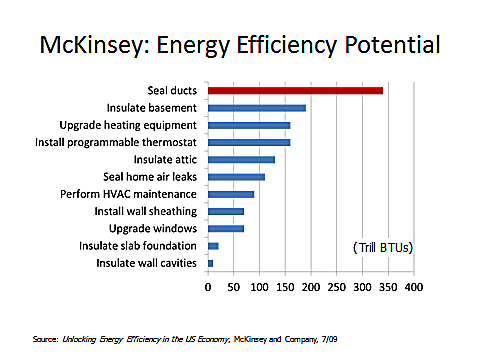In New Report, Aeroseal Duct Sealing Proves To Be The Single Most Effective Energy Savings Option For Small Offices And Homes
Case Study Finds Duct Sealing Payback in 5 Years vs. Furnace Replacement in 20
Effective Home Energy Conservation Strategies
 Duct sealing can be far and away the most effective strategy for reducing energy costs for homes, small offices and commercial buildings
Duct sealing can be far and away the most effective strategy for reducing energy costs for homes, small offices and commercial buildings
Centerville, OH (PRWEB) December 19, 2012
An article in the latest issue of the ASHRAE Journal reports that duct sealing with a new aerosol-based technology called Aeroseal, could be the single most effective and cost effective measure for reducing energy usage in small office buildings. Other recent studies have found similar results for home energy savings.
The ASHRAE Journal article, “Energy Audits, Improvements In Small Office Buildings,” was written by Ian M. Shapiro, president of Taitem Engineering, a consulting firm specializing in green building. The piece reviews the unique energy-related characteristics of small office buildings, and the various strategies available to reduce energy consumption. It also includes a case study example of one small office building that had undergone a complete energy audit and subsequent energy-savings retrofit that included the use of Aeroseal to seal the ductwork. Post-retrofit analysis found that aeroseal duct sealing had the highest impact on reducing gas and electricity usage and was the single most cost effective measure taken as compared to the various other energy-saving implementations.
In a 2009 study conducted by McKinsey Global Energy and Materials, an analysis of potential energy savings options for homeowners found that aeroseal duct sealing was 6 times more effective at saving home energy than replacing windows and 35 times more effective than insulating walls. The study also found aerosealing to be by far, one of the most cost effective energy conservation measures available to homeowners, with an estimated cost of $5 per BTU saved as compared to upgrading heating equipment, for instance, with a cost of approximately $12.5 per BTU saved.
In the Taitem Engineering study, the duct sealing paid for itself in about five years. In comparison, payback for insulating walls, air sealing and installing storm windows was about 18 years; the furnace was just under 21 years.
“The amount of energy savings we got from Aeroseal was actually much more than we anticipated,” said Shapiro. “The energy audit had predicted a savings of 58 therms/year, while actual savings turned out to be closer to 267 therms/year – that’s an annual savings of about $421 on gas and electricity. More surprising was the fact that there was as much leakage as there was, even though the ductwork had been sealed with mastic just two years prior.”
According to the report, the building’s ductwork – after mastic sealing – measured 350 cfm (cubic feet per minute). After sealing with Aeroseal, leakage measured 30 cfm.
“It’s clear from reports like these that duct sealing is now a critical aspect of energy savings,” said Neal Walsh, vice president of Aeroseal LLC, “and that simple tape or mastic doesn’t do the trick. With the introduction of aeroseal technology, duct sealing has quickly risen to the top of the list for energy saving options for both commercial and residential structures.”
About aeroseal technology
First developed in 1994 by researchers at the Lawrence Berkeley National Laboratory and funded by groups such as the Environmental Protection Agency (EPA) and Department of Energy (DOE), Aeroseal technology provides a highly effective method for sealing leaky ductwork from inside the duct system. The process involves injecting a fog of sealant particles into the ductwork. The particles seek out leaks within the duct system and quickly collect around them to create an airtight seal. The Aeroseal process has proven to be the most effective, affordable and viable method of sealing leaky ductwork systems – a problem that plague about 90 percent of homes and buildings in the U.S. today. The U.S. Department Of Energy estimates that aeroseal technology has the potential to save Americans $5 billion dollars annually. Currently, more than 75,000 homes and 400 commercial buildings throughout the U.S. have been treated with Aeroseal.
If you want to see the entire McKinsey and Company report from the source site, please click on the URL below

